Ex Vivo Transposon-Mediated Genetic Screens for Cancer Gene Discovery
- PMID: 30542998
- PMCID: PMC6296821
- DOI: 10.1007/978-1-4939-8967-6_12
Ex Vivo Transposon-Mediated Genetic Screens for Cancer Gene Discovery
Abstract
Transposon mutagenesis has emerged as a powerful methodology for functionally annotating cancer genomes. Although in vivo transposon-mediated forward genetic screens have proven to be valuable for cancer gene identification, they are also time consuming and resource intensive. To facilitate the rapid and cost-effective identification of genes that regulate tumor-promoting pathways, we developed a complementary ex vivo transposon mutagenesis approach wherein human or mouse cells growing in culture are mutagenized and screened for the acquisition of specific phenotypes in vitro or in vivo, such as growth factor independence or tumor-forming ability. This approach allows discovery of both gain- and loss-of-function mutations in the same screen. Transposon insertions sites are recovered by high-throughput sequencing. We recently applied this system to comprehensively identify and validate genes that promote growth factor independence and transformation of murine Ba/F3 cells. Here we describe a method for performing ex vivo Sleeping Beauty-mediated mutagenesis screens in these cells, which may be adapted for the acquisition of many different phenotypes in distinct cell types.
Keywords: Cell-based screens; DNA transposons; Ex vivo forward genetic screening; Functional annotation; Growth-factor independence; Sleeping Beauty; Transposon mutagenesis.
Figures



References
-
- Bergerson RJ, Collier LS, Sarver AL, Been RA, Lugthart S, Diers MD, Zuber J, Rappaport AR, Nixon MJ, Silverstein KA, Fan D, Lamblin AF, Wolff L, Kersey JH, Delwel R, Lowe SW, O’Sullivan MG, Kogan SC, Adams DJ, Largaespada DA. An insertional mutagenesis screen identifies genes that cooperate with Mll-AF9 in a murine leukemogenesis model. Blood. 2012;119:4512–4523. - PMC - PubMed
-
- Collier LS, Adams DJ, Hackett CS, Bendzick LE, Akagi K, Davies MN, Diers MD, Rodriguez FJ, Bender AM, Tieu C, Matise I, Dupuy AJ, Copeland NG, Jenkins NA, Hodgson JG, Weiss WA, Jenkins RB, Largaespada DA. Whole-body sleeping beauty mutagenesis can cause penetrant leukemia/lymphoma and rare high-grade glioma without associated embryonic lethality. Cancer Res. 2009;69:8429–8437. - PMC - PubMed
-
- Collier LS, Carlson CM, Ravimohan S, Dupuy AJ, Largaespada DA. Cancer gene discovery in solid tumours using transposon-based somatic mutagenesis in the mouse. Nature. 2005;436:272–276. - PubMed
-
- Dupuy AJ, Akagi K, Largaespada DA, Copeland NG, Jenkins NA. Mammalian mutagenesis using a highly mobile somatic Sleeping Beauty transposon system. Nature. 2005;436:221–226. - PubMed
Publication types
MeSH terms
Substances
Grants and funding
LinkOut - more resources
Full Text Sources
Medical
Miscellaneous

